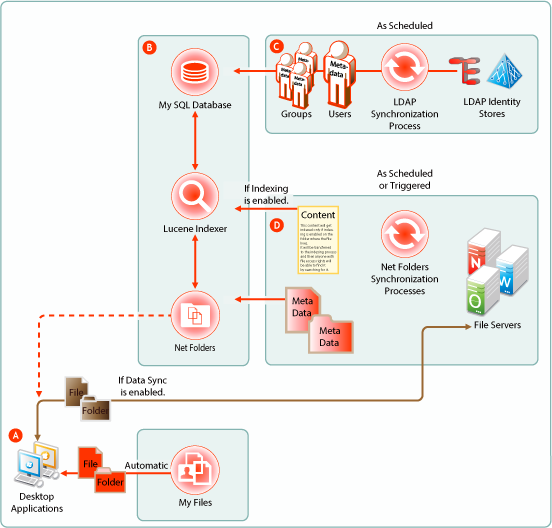13.1 Synchronization Overview
Figure 13-1 illustrates at a high level the information and content that get synchronized in Filr. The table that follows the figure describes some of the results and implications of the processes that take place.
The figure does not illustrate functional details. For example, it does not attempt to show the flow of LDAP metadata and file/folder metadata to Filr services for storage and indexing.
Figure 13-1 What Gets Synchronized

|
Letter |
Details |
|---|---|

|
The MySQL database, the Lucene indexer, and Net Folders work together to provide access to data through Filr. MySQL houses the Filr database. The Lucene indexer indexes all of the LDAP and file storage metadata so that search functionality is available. It also indexes file content for searching in folders that have indexing enabled. (See the note above letter C.) Net Folders provide users who have authenticated with proper credentials, access to files and folders on the network through the file storage metadata that is associated with them. |

|
A Filr LDAP synchronization is required when users are added or removed, or when group memberships change in the LDAP identity store. LDAP synchronization is essential to user access to their files and folders. For most organizations, it is usually sufficient to synchronize LDAP once a day. Others require more frequent synchronization to keep Filr abreast of changes in their identity stores. |

|
Because file and folder activity on network file servers can be in constant flux, and because synchronization needs vary greatly from server to server, Net Folder synchronization is multi-faceted and very flexible. You can set synchronization schedules for each Net Folder Server. The Net Folders associated with that server are then synchronized according to the general nature of the volume or share where they reside. You can also set synchronization schedules for individual Net Folders that will override the server schedules and synchronize the folders either more or less frequently than the server schedule dictates. You can perform manual synchronizations, which is a very useful feature when creating Net Folders to ensure that desktop application users can download local copies for access. You can enable Just-in-Time Synchronization (JITS) so that each time a folder is accessed from the Web or a mobile device, its content is synchronized with Filr. (The desktop applications do not trigger JITS.) |

|
Desktop applications for Windows and Macintosh workstations must download local copies of files and folders before users can access them. Before the files and folders in Net Folders can be downloaded, their metadata must be synchronized with Filr. (See the metadata synchronization process indicated below letter C.) For this reason, many Filr administrators perform a manual synchronization of the meta data when initially setting up a Net Folder. When users access the Net Folder from their desktops, they can immediately start to download the files and folders as expected. For home folders (My Files), the meta data is automatically downloaded so that home folder synchronization to desktop users begins the moment users first access their My Files area. After data is synchronized with the desktops, then as long as the desktops are connected with the network, changes to local copies are immediately synchronized with the file server. If the workstation is disconnected, then when the connection is restored, synchronization is automatic. |

|
Files and folders in Filr-based personal storage are automatically synchronized to the workstation’s file system. |

|
Note that the brown arrow passes through Filr. Net Folder and Home Folder files and folders are not stored in Filr. Instead, Filr simply facilitates the synchronization of the actual files and folders between the file server and the desktop clients. |

|
Net Folders are configured by default to allow data synchronization with desktop applications. However, the download functionality can be disabled. If the download functionality is disabled, then desktop application users will not be able to view or access the files and sub-folders in their assigned Net Folders from their workstations. (Unlike Web and mobile access, Desktop applications do not provide Net Folder browsing. Browsing within the desktop applications is limited to local downloaded copies of Net Folder files.) One reason that Filr administrators might disable the download functionality would be to prevent anyone from getting a local copy of sensitive files that must be stored only on the organization’s file servers. |